Hello everyone! Today, I’d like to share with you the journey and experiences that led me to become a Certified Scrum Trainer (CST) and my future aspirations. This has been a challenging journey, from initially aspiring to attain the CST certification to ultimately earning it, which spanned over a decade. As the old saying goes, “It takes ten years to sharpen a sword,” which vividly illustrates my perseverance and dedication.
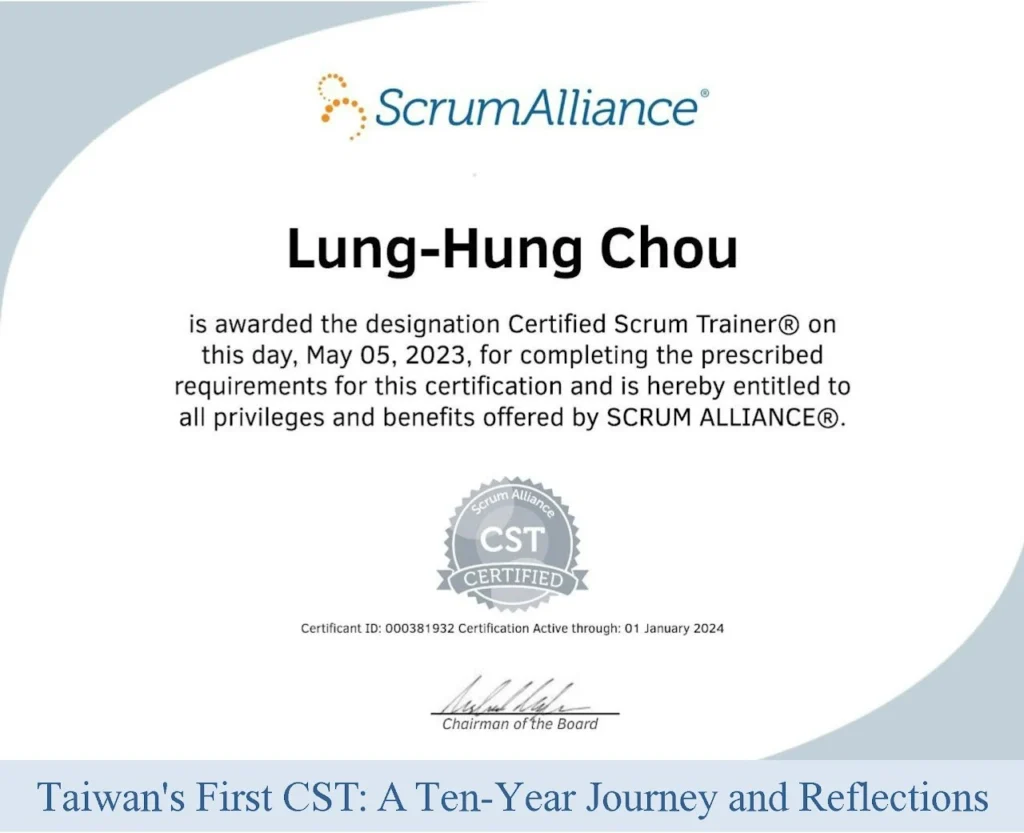
Becoming a CST: The Initial Aspiration
Going back to Christmas of 2014, I was first introduced to Scrum. At the time, I was already the first Program Management Professional (PgMP) in Asia, but I was eager to gain basic certification in Scrum, as it was a new way of working in line with the trends of the time. I recall when Bill Li, CST, our instructor, first came to Taiwan for training, where I sat with five other students around a single table. The course was different from anything I had experienced before, highly interactive, with Bill teaching us in a simple yet profound manner, emphasizing practical implementation. It left a deep impression on me.
After earning my Certified ScrumMaster (CSM) certification, I set a goal to someday teach Scrum and issue Scrum certificates like Bill. However, it took ten years to realize this aspiration. Despite this, I was able to persist for a decade to achieve my goal, eventually becoming the first CST in Taiwan.
The Practical Experience Phase as a Scrum Practitioner
Over the next five years, I was deeply involved in various projects and product developments, exploring the application of Scrum in different fields. Initially, I applied Scrum to information system development, including the company’s Project Management Information System (PMIS) and an iPad e-magazine for project managers. As Agile is deeply embedded in the IT industry, the development of these two products naturally succeeded.
Fascinated by challenges, I began to apply Scrum to non-IT fields. I led a team to develop an Agile Certified Practitioner (ACP) exam prep system, which included a coaching system, a question bank mechanism, and the writing of study materials, all following the Scrum framework. Moreover, I led a group of volunteers to promote the establishment of national standards using Scrum, which involved coordination and cooperation with the government and many industry experts, making the process very complex. Despite the difficulties, we managed to complete this seemingly impossible project and applied the Scrum framework to many other national standards, with six sets achieved so far.
I led a group of 100 volunteers to translate the international classic work of project management, the Project Management Body of Knowledge (PMBOK Guide). We spent about half a year translating the sixth edition into Chinese and ensuring its quality met publishing standards. Subsequently, we translated the seventh edition, published four years later. Both works were of excellent quality, and after publication, we received no errata from any readers. Furthermore, every half-year, I worked with an average of 50 volunteers per team to translate five international Agile classics (Mike Cohn’s “User Story,” Roman Pichler’s “Scrum Agile Product Development,” Lyssa Adkins’s “Coaching Agile Teams,” Esther Derby/Diana Larsen’s “Agile Retrospective,” and Geoff Watts’s “Scrum Mastery”). Each book took an average of half a year, requiring collective effort from all volunteers. These practices allowed me to continually test the effectiveness of Scrum in various scenarios.
My representative work before the CST interview was in 2022 when I hosted the RSG event (Taiwan Regional Scrum Gathering), an accomplishment that I am immensely proud of. We set a global record for the highest number of participants, attracting 888 attendees for the online conference, including 300 senior executives. We invited leading Agile coaches and experts worldwide, such as Dave West, Lyssa Adkins, Roman Pichler, and Geoff Watts, which gained more attention and influence for Taiwan’s Agile community.
Enhancing Competitiveness for CST Application: Pursuing a PhD and Acquiring a Coaching Certificate
In the puzzle of my life’s dreams, one piece is to pursue a doctoral degree. Intending to integrate it with agility, I decided to undertake a doctoral degree in business management from Taiwan’s top-tier National Sun Yat-sen University while working hard. My major was Competitive Dynamics Theory, a mainstream doctrine in strategic management. I noticed that many companies implementing agility do it very well, but they rarely integrate it with their strategy. Hence, it’s unusual to see highly profitable agile companies. During my doctoral studies, my focus allowed me to obtain my PhD in just three years, setting the fastest record at the university. If I become a CST in the future, I will be one of the few CSTs worldwide who hold a doctoral degree.
My most significant achievement in the application of strategic management is the successful combination of strategic management and agile methods, particularly integrating dynamic competitive strategy with Scrum framework. This is the main reason why the Taiwan RSG event mentioned earlier could achieve the highest global participation of 888 people.
In addition, I have immersed myself in formal coaching learning for over two years and have obtained the ICF-ACC certification, currently accumulating 325 hours of coaching time. I found that coaching techniques are a powerful tool and a professional skill that expands one’s horizon, breaks through limitations, and guides coachees to find their objectives. Whether instructing senior executives or general managers, I can effectively guide them to find solutions to their problems through coaching dialogues. This is a necessary core skill for the CSM course I teach. I’ve overcome the challenge of my subjectivity, striving to maintain the neutrality and objectivity of coaching, especially when facing the challenge of introducing agility. Through this skill, I have truly felt the value and influence of becoming a coach.
Co-training with CSTs
In the latter five-year journey pursuing CST, I began to embark on the path of teaching. To attain the CST qualification, I had to co-train with three different CSTs for at least 10 cohorts. This apprenticeship-style setup imposed significant pressure on apprentices like me. In the CSM course, I had to be responsible for at least 50% of the teaching content to be recognized. You can imagine, students invest a lot for their CSM certification, and as an apprentice, I had to shoulder half of the teaching responsibility. In other words, I had to perform almost as well as my mentor to meet the students’ expectations. Therefore, I spent a considerable amount of additional time honing my teaching skills and enriching my knowledge of Scrum.
I still remember my first co-training experience with the very experienced CST, Vernon Stinebaker. As a novice instructor co-training with him, who has led countless courses, I felt immense pressure and received many criticisms afterward. Faced with frustrations and difficulties, some might give up, but I am the type who becomes more determined after setbacks. I believed that one day, I could become an excellent CST instructor like him.
Co-training with the second CST was less challenging. The third collaborator was my mentor, Bill. I continued to work hard to improve my teaching skills. This experience was indeed the best training process in my CSM teaching, ensuring my teaching quality in the future. Although the minimum requirement to become a CST is to teach 10 cohorts of 100 CSM students, I have already taught more than 25 cohorts, with the number of CSM students exceeding 500. I successfully overcame the first hurdle of the CST application, and there are three more to go.
Building International Reputation
The second hurdle is that becoming a CST isn’t just about being an excellent instructor; the role is also that of an international Scrum ambassador for Taiwan. Representing Taiwan’s image internationally, it simultaneously embodies the expectations the international community has for Taiwan. As a CST candidate, I need to actively participate in the domestic agile community and have sufficient international recognition to fit this role. This is a substantial challenge. My experience in the domestic agile community is decent, but establishing enough international recognition requires speaking and gaining exposure in different countries.
The way I built my international reputation is quite unique. I selected some videos of well-known agile experts and translated them into Chinese for the Taiwanese agile community. Through this translation process, I was able to interact with many agile experts, ask them questions, learn new knowledge, and they were even happy to let me translate their videos into Chinese for Taiwanese learners. This approach allowed me to establish a network with many international agile masters (such as: Mike Cohn, Roman Pichler, Lyssa Adkins, Henrik Kniberg, and Jeff Sutherland…etc), who are generally hard for most people to reach. I spent a full four years deepening my professional knowledge and building a certain level of international reputation. Below is the collection of all the 40 videos I translated:
https://sites.google.com/view/rogersagileselect/home
Finally, I began to formally apply to the Scrum Alliance to become a CST. This was truly the start of a long and agonizing process.
Official CST Application
In November 2020, I submitted my first written CST application, hoping to teach using the old version of the Scrum Guide before the 2020 update was released. However, from the start of the application to officially becoming a CST on May 5, 2023, I went through a 2.5-year period. During this time, I had to complete a very rigorous and challenging CST application plan, averaging over 410 pages each (389 pages the first time, 553 pages the second time, 296 pages the third time), including the future course materials I would use for CSM teaching.
In this process, I went through 3 formal document reviews, with two applications being rejected. In each review process, the review committee gave very detailed feedback, which I had to carefully inspect and adapt. The Scrum Alliance would point out areas that needed improvement. As I have high standards for myself, every time after a review, I made improvements that went beyond the committee’s expectations, and I successfully passed the third hurdle 2 years later. Many people might think my 2-year application process was lengthy, but in reality, many CST application processes are even longer. Some pass the review on their fourth or fifth attempt, or the application process can take as long as four to five years. Therefore, compared to others, my 2-year application process can be considered relatively short. The final hurdle is the CST interview. I had to physically fly to the country where the Scrum Alliance’s Global Scrum Gathering (GSG) was held to attend the interview. In November 2022, I flew to Lisbon, Portugal, which is about 10,000 kilometers away from Taiwan. I had prepared thoroughly for three months before this interview, but I didn’t pass.

Continuing the Retake Journey, I had pass most stringent Scrum Test
CST interviews are such that no matter how well you prepare, you will encounter some uncontrollable factors when you’re in the field. So when I didn’t pass the interview, I realized this. That time, I traveled back and forth a total of 20,000 kilometers to attend the interview with my younger brother and mother. Of course, I was very disappointed after returning. But this became the biggest driving force for improving my teaching methods.
After returning, I started correcting the shortcomings from my previous interview. The first issue was the lack of interactive teaching and activity design. I started focusing more on TBR (Training from the back of the room) and trying to give students more hands-on time in class, as practice enhances learning. In the next six months, I went through many large company Scrum training sessions and wrote a best-selling Agile book, “Successful Agile Product Management”, which sold 9 editions in just 5 months (the first edition had 1,000 copies).
The second shortcoming from the interview was insufficient depth of Scrum knowledge. Therefore, I used the world’s most stringent Scrum expert test, the “PSM3 certification”, to challenge my Scrum skills. Only 1,000 people worldwide have passed this stringent Scrum touchstone, and only three in Taiwan, two of whom are PSTs. Although I didn’t pass this certification the first time, succeeding later sharpened my knowledge to its best state and became the best proof of my in-depth knowledge of Scrum.
My Journey to Becoming a CST: The Final Stage
Six months later, I underwent a second interview, this time in Portland, USA, a city similar to Kaohsiung in Taiwan. I successfully passed this interview. These two experiences led to substantial progress in my teaching abilities. Initially, I thought that I had hit the ceiling in my two decades of teaching, but in order to pass the fourth stage, I found that I could still make even greater strides.
On the 5th of May, 2023, I became the first person in Taiwan to obtain official certification as a Scrum Alliance Certified Scrum Trainer (CST). This is a very important and proud milestone for me. On that day, my family: my mother, my loving wife, and my brother were present to witness this moment and share in this joy.
The CST (Certified Scrum Trainer) certification, issued by the globally largest and most influential Scrum Alliance, is the highest and hardest to obtain Scrum certification in the world. Currently, there are only a little over 200 CSTs globally. Their role is to instruct Scrum and other agile methods, fostering effective collaborative work environments. In Taiwan, no one has yet achieved this honor. Even in mainland China, there were only 8 CSTs to date, even though the first one appeared a decade ago. Becoming a CST requires a wealth of knowledge and skills, mastering the core concepts and methods of agile development, and being able to help teams achieve fast and efficient product development. Passing the CST exam to become a Scrum trainer not only showcases personal abilities but also serves as a local international Scrum ambassador, making significant contributions to the development of various industries.
When the representative of the judge announced, “Congratulations, you have been approved as a CST, welcome to join the international Scrum ambassadors,” I was moved to tears. This was the result of my years of hard work, and I was proud of being able to achieve my goal while also opening new doors for agile development in Taiwan.
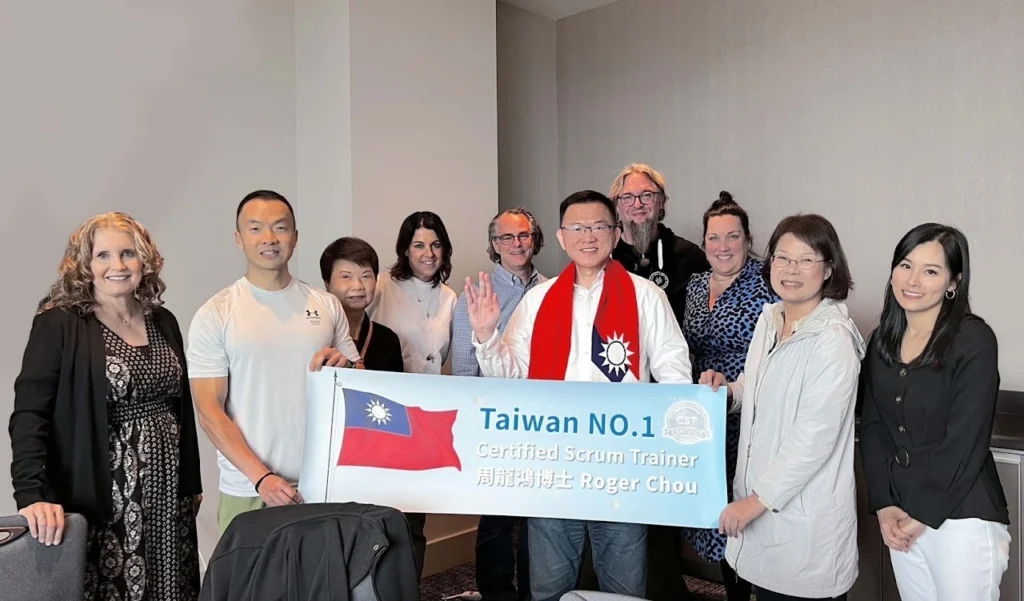
Looking back, I received Asia’s first Project Management Professional (PgMP) certification in 2009 and then became one of the first three CSPs of the Scrum Alliance in Taiwan. Starting in 2014, I collaborated with Bill Li, a Canadian CST, to train over half of Taiwan’s CSM students, numbering over 1000. In 2015, I received the Agile Award for Best Agile Promoter and founded Taiwan’s largest online agile community in 2019. Currently, the community has over 5000 members, and we provide free agile learning resources every month. These efforts have made important contributions to the development of Scrum in Taiwan.
I want to tell everyone that obtaining CST certification is for me, merely the beginning, not the end. I aim to assist 100 non-IT enterprises successfully adopt Scum within 10 years. Up to now, I have successfully conducted Scrum training for six companies including the Pfizer Pharmaceuticals, GSS Information Company, Far EasTone Telecommunications ETC, Ricoh Company of Japan, Nissan’s IT department, and the industrial giant Wistron NeWeb Corporation (WNC). In addition, I have also held large-scale agile workshops for principals of over 30 junior and senior high schools, in hopes of strengthening the promotion of school affairs plans through the introduction of agile mindset.
I want to thank everyone who has supported me along the way. Your encouragement and help are my motivation to move forward. I also want to encourage everyone to always adhere to their own beliefs and never give up on their efforts to pursue their dreams. As long as we are willing to make efforts, we can achieve our goals. I am extremely proud to have made a small contribution to the development of Agile in Taiwan, and I look forward to a better future. Let us meet this challenge together and create more Agile success stories for Taiwan!
2023/5/27 (Saturday) 02:00 Official announcement from Scrum Alliance
Join us in congratulating Roger Chou, PhD, CST on becoming our newest Certified Scrum Trainer (CST). Great job on this accomplishment! #ScrumAlliance #AgileCoach
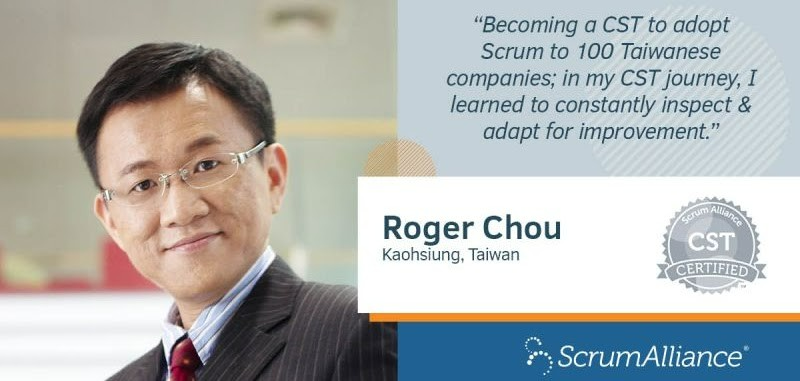
Vision After Becoming a CST
My self-expectation is “With great power comes great responsibility”, just like the famous quote from Spiderman. My vision for the future is to assit 100 non-IT enterprises successfully adopt Scrum in the next 10 years. My expertise is not limited to the IT field, but rather, enterprise strategic management.
To realize this vision, I have set several important product goals. First, in the next two years, I hope to train 100 CEOs to become CSMs (Certified Scrum Masters). These CEOs include not only business leaders with over 100 employees, but also high-ranking government officials and school principals.
The second product goal is to cultivate 1,000 CSM in Taiwan, including 100 CEOs. I believe that the individuals who participate in CSM training in the future will be more potential Agile practitioners or managers that will support the companies in adopting Agile practices.
The third product goal is to train 1,000 highly competitive Scrum Masters (SMs). Many people may doubt whether CSMs have the ability to become SMs or possess sufficient competitiveness. However, I believe that through our training, subsequent practical experience accumulation, and the mutual assistance and communication within the community, their capabilities can improve rapidly.
Lastly, my vision as a CST is to assist 100 non-IT enterprises successfully adopt Scrum within the next 10 years.
This is my vision for the future. I know this is a challenging road, but I believe that as long as I have firm belief and relentless effort, I will definitely achieve it.
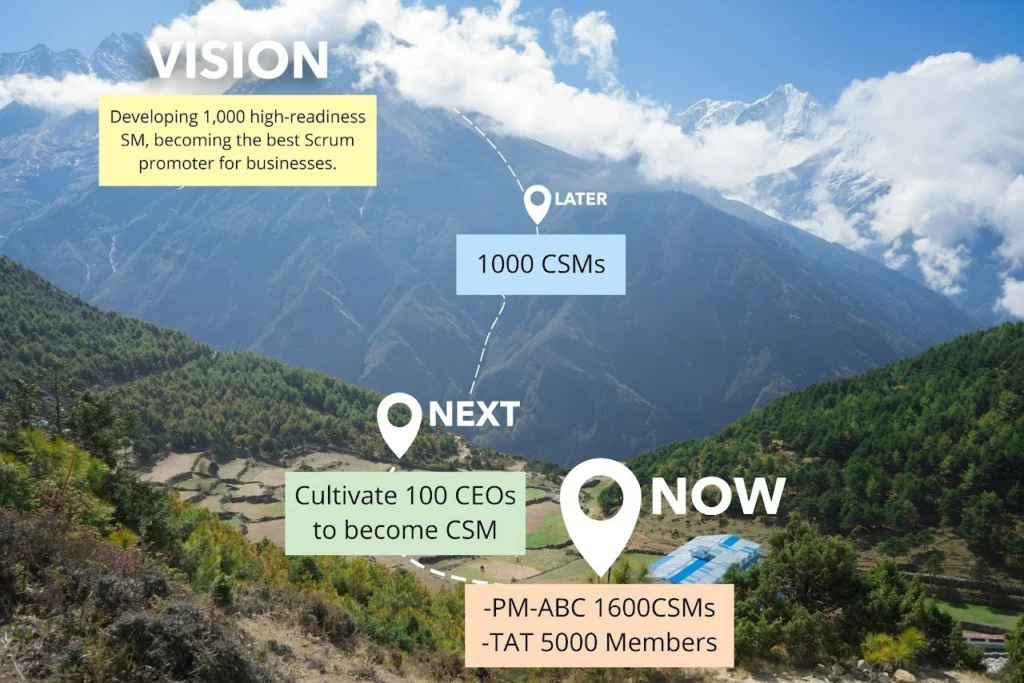
The Roadmap and Execution After Becoming a CST
After returning to Taiwan, I immediately initiated my CST roadmap plan. In fact, during the 15 hours on the plane, I had already completed the entire product roadmap for CSM, as well as my first milestone CSM training program for 100 CEOs.
Last Thursday (May 18), I publicized my training plan for 100 CEOs and received a lot of positive feedback from many companies. What surprised me was that the 100 CEO slots I initially planned to invite in Taiwan were filled in just three days. At present, there are still 12 CEO candidates from different companies on the waiting list. This is very encouraging for me, as I never imagined Agile would have such a high demand in Taiwan.
However, among the participating CEOs, only two are government officials. Since Agile development requires participation and cooperation from multiple parties, I hope to have more government officials involved. Therefore, I have opened up an additional 20 slots specifically for government officials, and 5 have already signed up to participate.
It seems that the original goal of training 100 CEOs within two years may now only take one year to achieve. As more and more people join, I believe that the goal of training 1000 highly competitive SMs will also be achieved sooner.
After planting these seeds, I hope to realize my vision without having to wait ten years. Of course, I can’t predict how much time it will take, but I believe that as long as we continue to uphold the spirit of Scrum’s transparency, inspection, and adaptation, we will reach our goals even faster.
Let’s work together for the future development of Agile in Taiwan!
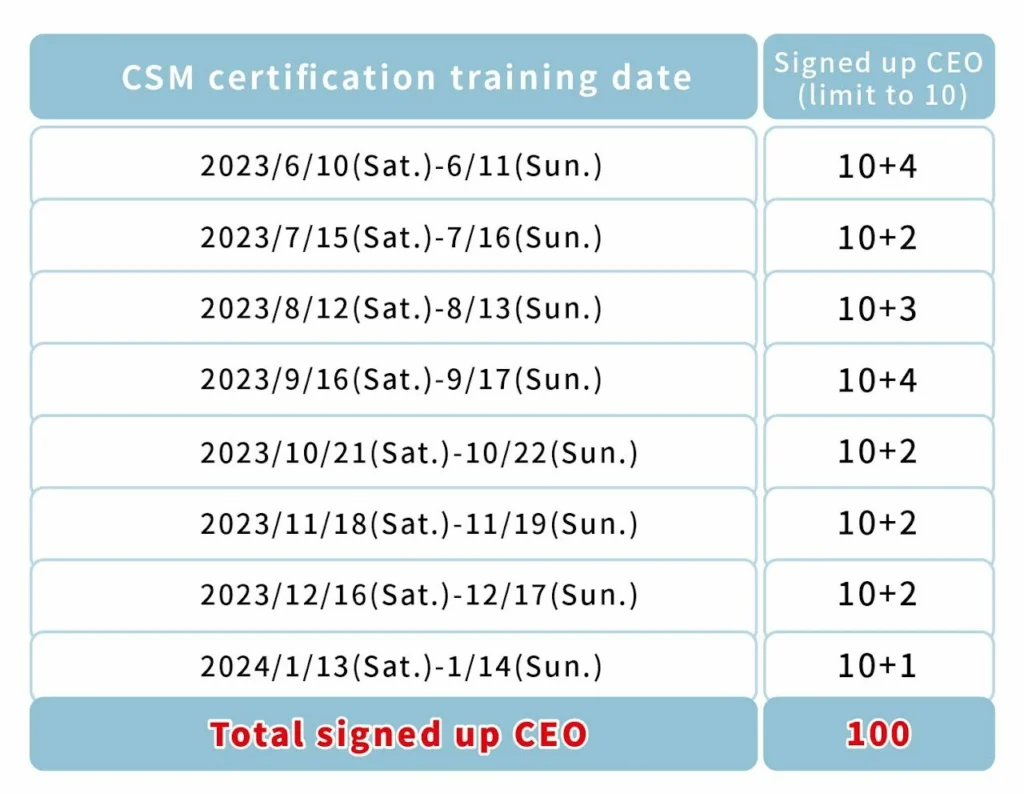
List of People to Thank
There are so many people to thank for helping me become the first CST in Taiwan. If your name is missing, please let me know.
CST: Bill Li, Jacky Shen, Vernon Stinebaker, Lance Zhang, Mike Cohn, Roman Pichler, Lyssa Adkins, Bernie Maloney, Ilsoo Ahn, Venkatesh Rajamani, Timon Fiddike, Kris Philippaerts, Chris Li
Family: Mom, Elly Chen, I Hung
Scrum Alliance: Tristan Boutros, Michael Meissner, Ashley Drake
TAC: Erika Massie, Lisa Reeder, Dave Prior, Judy Neher, Björn Jensen, Lonnie Weaver-Johnson, Xavier Quesada Allué, Iain McKenna, Ethan Huang, Anu Smalley, Michel Goldenberg
CST Journey Benefactors: Lauren Pan、Riva Chen、葉維銓、Chungan Ke、Ina Lin、王龍飛、吳璨因、喵咭、Simon Chen、Garfield Ying、Tomas Li、Yves Lin、徐光明、陳國欽、羅正普、戴劍文、曾文仙、林家瑋、Nini、黃姿菱、郭唐伶、李晏芳、王心宜、連彗雅、葉娀妤、敏瑜
Thank Heaven: Kui Xing Sir, Wen Chang Emperor
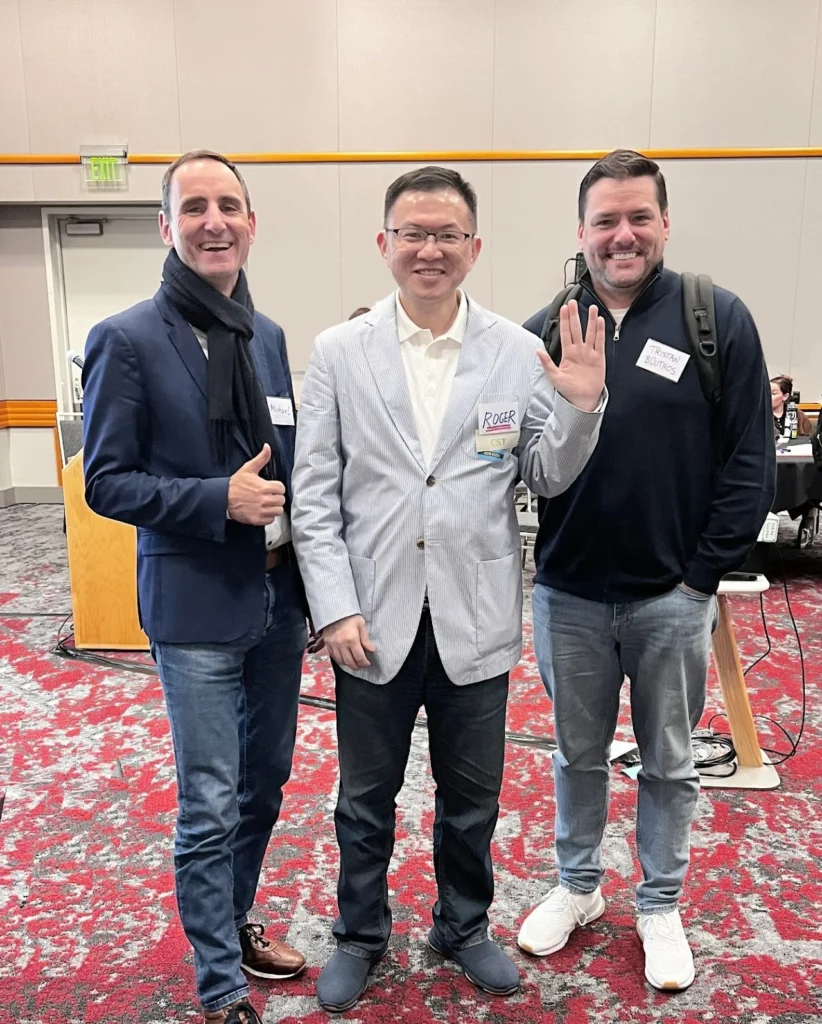
Epilogue
At the conclusion of this piece, I wish to share with everyone the feelings I experienced at the moment I received my commemorative CST pen. In life, everyone goes through different stages of significant milestones, and this time, my experience of receiving the CST pen has profound significance for both myself and the entire society of Taiwan.
I had a commemorative pen made, with the letters CST engraved on the clip. This pen is part of Montblanc’s “Around the World in 80 Days” series. An elephant is carved on the side of the pen. In my eyes, the elephant not only represents wisdom but also symbolizes the CEO of a corporation. When I hold this pen, what I feel is not just its weight, but more so, the sense of mission that CST carries. I firmly believe that under my leadership, Taiwan’s agility will bring about a transformation in the ecosystem.
